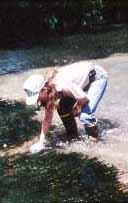Call our 24-Hour Communication Center (512) 389-4848 - Austin
Kills and Spills Team
 Conducting
an Investigation
Conducting
an Investigation
Immediately after a kill or spill is reported, an investigation begins. Though differences exist between investigating fish and wildlife kills and spills, the need for prompt response and accurate analysis applies in either case. Hours and minutes count upon notification of a kill or spill because crucial details can be lost in a short amount of time. Indeed, in a process much like detective work, the TPWD biologist must pay close attention to details, follow proper sampling procedures, and keep valid records. After piecing together the clues, the investigator can then best determine the source of a spill and/or the cause(es) of a kill.
Each cause of a kill or spill usually has specific characteristics surrounding it. Such clues visible to the naked eye include physical indicators of water quality. However, a wise investigator follows through by completely assessing the site. After collecting adequate samples, recording data accurately, and conducting thorough lab analyses, he/she can narrow in on the specific cause. Certain factors might be easily overlooked due to their assumed insignificance such as weather, vegetation, algal blooms, water chemistry, water flow, and pollution. However, when a rapid change in one or more of these factors occurs in a river, stream, estuary, ocean, or other aquatic ecosystem, serious impacts may result. Thus, an investigator of a kill or spill must learn the importance of carefully and accurately assessing the whole environmental picture.